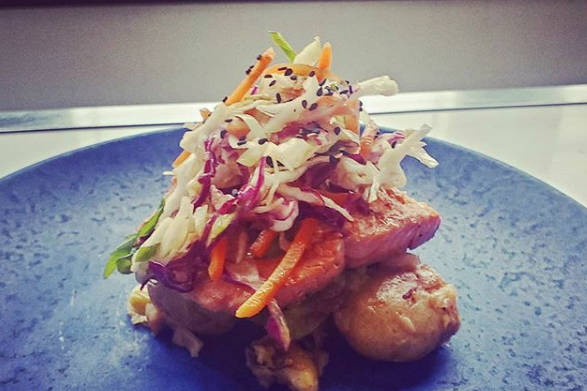Whether seared, poached, grilled, or raw, wild salmon not only holds a ubiquitous presence on B.C. menus, it is irrevocably connected to the province’s identity.
The same can be said for cannabis. Without going into the quality or potency of the strains during prohibition, B.C.’s lax enforcement on recreational use was critical in sealing our reputation in cannabis culture. It’s only natural, post legalization, for the rest of Canada to watch how B.C. might elevate cannabis to the next level.
Nowhere is this more evident than the world of edibles. Yet beyond the sweet and starchy dessert approach, there is a burgeoning field of high-scale cannabis cuisine with one chef in particular leading the way, The Nomad Cook, Travis Petersen.
“This is the newest frontier in the culinary world, and Canadian chefs are the among the first to really get to experiment with it legally,” Petersen said.
He views cannabis as a super food with a wealth of health benefits when used properly. With the high, fatty omega-threes and other nutrients of salmon, the two items pair perfectly for healthy and enticing dishes.
Petersen is a self-taught chef and Vancouver native. After competing on the television show Master Chef Canada in 2016, he left his sales and marketing career to start The Nomad Cook featuring cross-country pop-up dinners and in-home dining. After two years he saw an opportunity with cannabis cuisine, which has been his primary focus ever since.
It’s common for cooks to simply add cannabis oil to prepared foods, but Petersen takes care in his selection of cannabis strain then through a long process extracts the cannabinoids as its own ingredient, with its own flavour profile.
“I look at the terpene profile of the cannabis first, where the flavours and aromas of the cannabis come through, as with any fruit, herb and plant, and then build the dish out that way.”
“I don’t really look at the food and then match it with the cannabis,” Petersen said. “I look at the cannabis and match it with the food.
The key to good cannabis cuisine is foods that bind well with CBD and THC. In other words, foods high in saturated fats, like salmon.
One dish of note is a seared salmon with a crispy skin accompanied with purple asparagus. For the cannabis infusion he creates a mint pea nosh with beta pinene, a terpene similarly found in pine cones and oregano, and which also acts an anti-inflammatory agent.
“The purpose of this dish is, when we get a more conservative base that asks why they would want cannabis in their food, we can tell them we’re creating a dish that will really help with body rejuvenation and relaxation.
“The beta pinene in this dish is already coming from the green herbs in the sauce. Adding the beta pinene and the CBD from the cannabis to this dish, there’s no stand-out cannabis flavour, but a nice smooth flavour that’s been enriched.”
Petersen’s Instagram page is loaded with dozens of elegant dishes like this, inspired by an assortment of west coast seafood, including BC spot prawns and glass rice noodles in an infused coconut broth; crispy-skin halibut with basmati rice and a mango salsa infused with mycrene and CBD; and a new take on an old classic, fish ‘n chips with CBD infused tartar sauce.
When Petersen got started he was cautious that cannabis cuisine was nothing more than a fashion in the early stages of legalized edibles. But in the last two years he’s served his cuisine across North America to more than 4,000 people, 18 per cent of whom were trying cannabis for the first time — what Petersen calls the “canna-curious”.
With his elevated approach, he’s intentionally trying to attract a more conservative crowd to the experience with the aim of further breaking down the stigma associated with cannabis use. On many occasions he’s served guests who just five years ago were against legalization. Within the next decade Petersen predicts the popularity of cannabis cuisine will only rise as old stigmas crumble.
“I’m trying to put culinary cannabis in a new light. Most people associate edibles with brownies, cookies and gummies, but we’re approaching this as with a truffle or saffron or any other premium ingredient a chef loves to work with. We’re trying to show people there can be a deeper purpose.”
Travis Petersen’s cannabis cusine, a teriyaki Pacific coho salmon, sapporo braised leeks, crispy baby potatoes and infused sesame slaw (+10mg THC). Submitted photo

